Swindon Town
In the mid-nineteenth century the Great Western Railway company established their locomotive works in Swindon on the main line between London, Bristol and South Wales. The resulting influx of labour brought a population explosion and it was only a matter of time before a professional football club was formed to attract the crowds on a Saturday afternoon.
Officially Swindon Town were formed in 1881 but recent research suggests that in December 1879 the Revd William Pitt, generally accepted as the founder of the modern club, played for a Swindon Association Football Club in a game against Rovers FC. Further research by Paul Plowman has unearthed an after-dinner speech from 1911 when the Revd Pitt, in his latter years, described how he had "formed the present club back in 1879." It seems that the original Swindon AFC changed their name to Spartans after amalgamating with the cricket club of that name and then merged with St Mark's Young Men's Friendly Society in 1881. The club became Swindon Town in 1883. In 1884 they moved to a new ground known as The Croft and in 1894 they turned professional and joined the Southern League. Two years later Swindon took out a lease on the County Ground where they remain to this day. After playing in white shirts (augmented by a blue sash when colours clashed), Swindon adopted red and black before turning out in green and white shirts in September 1897.
In 1901 Swindon adopted maroon jerseys. Around 1904 they appear to have become a rather lighter shade of dark red and the photographic evidence suggests that jerseys in deep maroon or dark red were used at least until 1929. (It is perfectly possible that the lighter tops were the result of fading but equally the variations may have been due to manufacturers using different dyes.) In 1910 Town reached the semi-final of the FA Cup where they were knocked out by Newcastle. The following season they won the Southern League championship and went on to lose 4-8 to Manchester United in the Charity Shield.
In 1921 Swindon, along with the rest of the Southern League First Division, became founder members of the Third Division of the
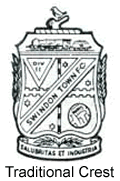
Football League. It is unclear when the club adopted their traditional crest but this only appeared on official documents. The town's connection with the Great Western Railway was represented by a steam locomotive, a robin appears at the top while the Latin script means "Health and Industry," which is also the town's motto.
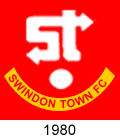
In 1958, when the regional divisions were abolished, Swindon were placed in the new national Third Division. A crest was adopted in 1961 that featured a robin, a traditional nickname for the team.
Swindon promotion to Division Two in 1963 but two years later they were back in theThird Division. 1968-69 was without question Town's finest season todate: against all odds they reached the League Cup final and on a mud-bound pitch beat Arsenal 3-1 in extra time to take the trophy. Six weeks later they clinched promotion to Division Two.
In 1972 a smart modernist crest was adopted that became known as the "ST Arrow" or "Traffic Sign" badge. It
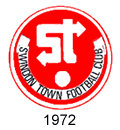
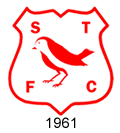
remained in use until 1986 although a simple "ST" monogramme appeared in some seasons and between 1976 and
1980, was absent.
Simplified versions were worn between 1980 and 1986.
In 1974 Swindon dropped back into the Third Division and in 1982 they dropped into the Fourth
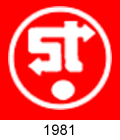
Division for the first time.In 1986 the traditional crest was revived and that season Swindon
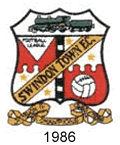
won the Fourth Division title. A year later they made their way through the play offs to return to Division Two and in 1990 they earned the right to play in Division One by
winning the play-offs but, owing to irregularities over payments to players, they were punished by having their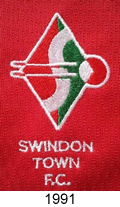 promotion cancelled.
promotion cancelled.
In 1991 the board appointed ex-England star Glen Hoddle as player-manager and the team underwent a makeover. A new crest was introduced in red, white and green and the team strip became all-red with white and green trim.
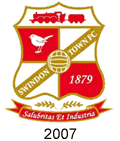
Two years later, having finishing in fifth place, Swindon won promotion to the Premier League via the play-offs. Hoddle departed to manage Chelsea and it quickly became apparent that the club was out of its depth. After conceding 100 goals they finished last and were relegated to the Endsleigh League Division One. Relegated again the following season, Swindon bounced back but in 1999, the club was forced into administration and was relegated to Nationwide Division Two (the old Third Division).
In April 2007 the club consulted with supporters over the reintroduction of the traditional crest and offered three alternative designs. The winning version was worn from the beginning of the 2007-08 season.
Financial problems continued to plague the club who faced winding up orders brought by HMRC over unpaid tax in 2006-07 and were at one stage paying around 2% of their turnover to pay off their debts. In 2008 a consortium led by Andrew Fitton and Jeremy Wray took
control with a commitment to pay off their debts.
